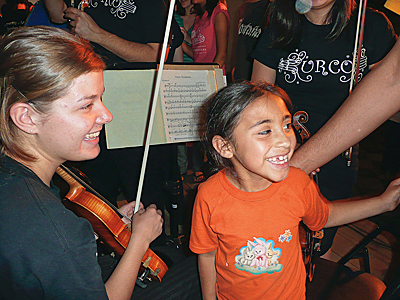In Review
 INTERNATIONAL RELATIONS: Hannah McDonough ’10 greets a fan after the University Chamber Orchestra’s concert for schoolchildren in Paine, Chile. (Photo: Lori Foster/Courtesy of the Department of Music)
INTERNATIONAL RELATIONS: Hannah McDonough ’10 greets a fan after the University Chamber Orchestra’s concert for schoolchildren in Paine, Chile. (Photo: Lori Foster/Courtesy of the Department of Music)“When you are in the practice room, by yourself, you must be strict and critical with yourself in a way no one else can be,” says cellist Leah Rankin ’10, a double major in English and music and a member of the University Chamber Orchestra.
“Through repetition, you learn dedication and perfection, a good way to approach a lot of things in life that are important to you.”
When Rankin and fellow members of the ensemble toured Chile this winter to perform the works of Beethoven, Mozart, Barber, and Copland, they met music lovers who have a similar appreciation for rigor.
The orchestra presented concerts in Valparaiso and at the Universidad Andrés Bello. The ensemble also gave a special concert for young children of migrant workers and a full concert in Paine with one of the most celebrated youth orchestras in South America, the Orquesta Sinfónica Estudiantil Región Metropolitana.
“The amazing thing about Chile as a nation is that the people there view youth orchestras as a way of building their culture and creating personal discipline and thoughtfulness,” says conductor David Harman.
Among the trip’s highlights, he says, were an appearance on the Chilean national television evening news, a reception at the U.S. ambassador’s residence, a hike to the San Francisco glacier in the Andes, and the New Year’s Eve fireworks celebration in Valparaiso.
“Easily the most rewarding aspect of the tour was the chance to share music with one of Santiago’s leading youth orchestras,” says clarinetist Kathryn Young ’09, a brain and cognitive sciences major from Delmar, N.Y. “When both orchestras played together, real magic happened—the music and the musicians were transformed.”
According to Sandra Perroni, the cultural liaison for the U.S. Embassy in Chile who assisted Harman with tour arrangements, there are currently more than 250 youth orchestras throughout Chile.
“It is widely held in Chile that children who develop proficiency on a musical instrument do better in school, exhibit higher levels of concentration, work together more effectively with others as a team, explore more opportunities to develop their talents, and contribute to their communities throughout their lives,” Perroni says.
It’s a point of view that strikes a chord with the College musicians, who come to the chamber ensemble from fields throughout the humanities and sciences.
While classical music education and appreciation in the United States may not be as strong generally as it was 50 years ago, Harman says, there is a bottom line that remains clear, across cultural borders and class lines.
“If you don’t practice, you don’t get better—it’s a simple but somehow difficult thing to learn in life. It is something anyone who genuinely loves music, who loves learning, knows in their heart to be truth.”
—June Avignone
